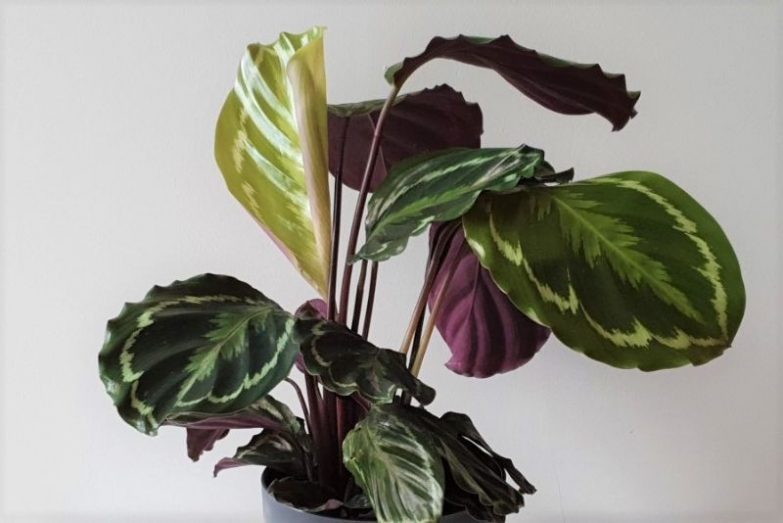The brilliant, rose-colored pallet of Calathea roseopicta’s patterned foliage is hugely popular – but there’s a catch. Calatheas generally deserve their fussy reputation, and the lovely Roseopicta is one of the worst offenders. In this article, we’ll explain everything you need to know about Calathea roseopicta care, to keep your plant healthy and beautiful.
Calathea roseopicta needs bright indirect light, consistently moist soil, and high humidity. The soil should be well-draining with enough aeration material to never become soggy. Normal room temperatures are suitable; avoid cold below 60ºF (15ºC). Feed lightly during the growing season.
Calathea Roseopicta Overview
Calathea roseopicta has the common name of Rose-Painted Calathea. Botanists have reclassified the scientific name to “Goeppertia roseopicta,” so Calathea is actually a synonym now.
Calathea roseopicta is a member of the Prayer Plant family and naturally grows beneath the Brazilian rainforest canopy. Its broad tropical foliage has a feathery pattern of bright pinks and fuschias that looks hand-painted on the deep green leaves. The colored stripes tend to whiten with age.
The undersides of the leaves are a flashy red-purple – at night the plant folds up and becomes a burgundy display. The plant is evergreen, so you can enjoy its color year-round. It grows from a rhizome and has a clumping growth habit, and reaches about 20 inches high.
Calatheas were discovered in 1869, so it’s unsurprising that a large number of cultivars have accumulated over the years – it’s one of the things that make this species so special. Calathea roseopicta hybrids may have unique leaf shapes, patterns, and colors; their consistent feature is a feathery border pattern.
The eye-catching plant offers many rewards, but it isn’t for the novice gardener.
Calathea Roseopicta Care Summary
| Scientific Name | Goeppertia roseopicta (Calathea roseopicta is an accepted synonym) |
| Common Name | Rose-Painted Calathea |
| Origin | Brazil, Colombia, Peru and Ecuador |
| Light Requirements | Bright, indirect light. Place in a bright room, but avoid direct sunlight. |
| Watering | Water thoroughly once the top inch of soil feels dry. check your plant regularly and carefully to see if it needs to be watered. Make sure to let the pot drain thoroughly after watering. |
| Soil | Well-draining, but moisture-retentive soil. (Link to great options on Etsy). If using a pre-made potting mix, try adding 1/3 perlite to improve drainage. |
| Temperature | 64ºF (18ºC) to 75ºF (24°C). Avoid temperatures below 60°F (15°C). |
| Fertilizer | Fertilize with a balanced preparation every 4-6 weeks during Spring and Summer. |
| Humidity | Minimum 40%, but >60% is much better. Will develop brown leaf edges in low humidity. |
| Flowering | Unlikely to bloom indoors. Small white or purple flowers grow directly from the rhizome on short stalks. |
| Pruning | Prune dead or damaged foliage just above soil level to keep your plant looking its best and to reduce risk of pests or disease. |
| Propagation | Calathea roseopicta can be propagated by dividing the rhizome of a mature plant. |
| Re-Potting | Often struggles after repotting, so wait until growth is restricted or your plant becomes very rootbound. |
| Diseases and Pests | Prone to pests including spider mites, mealybugs, thrips, scale, and fungus gnats. Quite resistant to disease unless overwatered. |
| Toxicity | Non-toxic |
| Where To Buy | Buy Calathea roseopicta online at Etsy (I buy most of my houseplants from Etsy). |
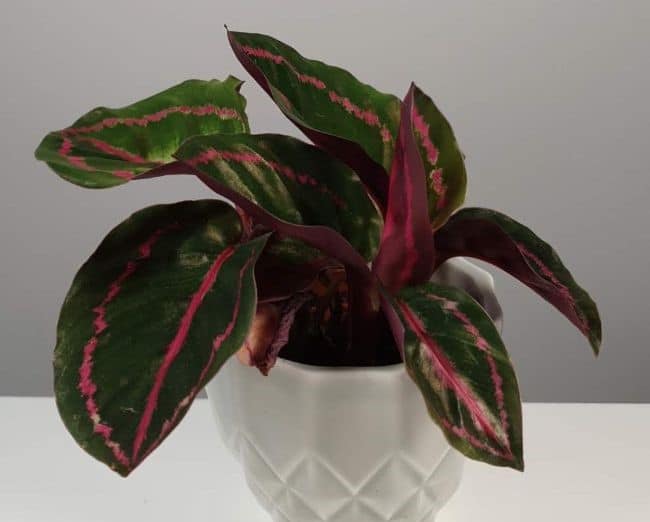
Calathea Roseopicta Light Requirements
When planning your Calathea’s lighting environment, remember they are essentially ground cover living underneath a shady rainforest canopy. Their leaves are well adapted to absorbing scarce light and move constantly to optimize reception.
The Calathea roseopicta likes moderately bright, indirect light, which can mean rather bright conditions indoors. Keep in mind that outdoor shade is actually brighter than most indoor space … light drops off very quickly with each foot of distance from a window.
Possible light locations that suit Calathea roseopicta:
- Six to ten feet from a window facing north, west, or east; just beyond the reach of direct sunlight.
- Inside a bright room but protected from intense light.
- A space with adequate artificial lighting.
As sunlight drops significantly in winter, you can move your Calathea to a sunny windowsill to compensate.
Lighting is arguably the most crucial aspect of Calathea roseopicta care. You can read my guide to houseplant lighting, to make sure you get it just right.
How To Water Calathea Roseopicta
Proper soil moisture is one of the keys to Calathea roseopicta care, as you’ll soon find out if you don’t water correctly. The mix should remain consistently moist without being sodden.
The critical danger of overwatering is root rot. Because Calathea roseopicta has a rhizome structure, it is vulnerable to being overrun with exuberant rot pathogens in soggy conditions.
The general rule is to let the top half-inch of soil dry out before rewatering. Water thoroughly … it should take the soil approximately a week before it needs watering again.
Don’t water on a schedule, but instead monitor the soil vigilantly. (Yes, this is why the plant is considered high-maintenance.) You can’t ignore your Calathea rosepicta without repercussions.
Adjust to your plant’s needs. For example, if the leaves show signs of dryness, consider waiting for only the surface of the soil to dry before rewatering.
Other watering tips:
- Don’t depend upon the plant to “tell” you it’s thirsty – their leaves are busy doing other things. Wilting will harm the foliage.
- It’s a good practice to let excess water drain through the soil at watering time. This flushes the soil of unused fertilizers and other potential toxins.
- If you use a self-watering device or another automatic method, monitor the plant’s soil regularly to make sure it is working properly.
- Cut down on watering over the winter. Keep the soil more crumbly and light.
- Use room-temperature water to avoid stressing the plant.
- Consider using rainwater or dechlorinated water that has been filtered or distilled. A Roseopicta can be sensitive to the salts, minerals, and various chemicals in tap water.
- Avoid letting your Roseopicta’s leaves remain wet overnight, which can invite fungal infections. Water early enough that the plant dries before nightfall.
Calathea Roseopicta Soil Requirements
Proper watering is only part of the moisture equation: the soil must be fast-draining and have enough aerating structure to keep the roots supplied with oxygen at all times, even after a thorough soaking. The soil should remain rainforest-damp, never sodden.
Some growers choose a soiless mix, but you can use regular potting soil and increase its aeration by adding perlite. You may need to add from 1/5 to 1/3 perlite to have a mix with enough “fluffiness.”
When you water your plant, the water should sink into the soil within seconds. If water pools on the surface, it is likely that the soil is too dense and not sufficiently well-draining. Read my guide to making and buying houseplant soil to get the perfect soil for your plants.
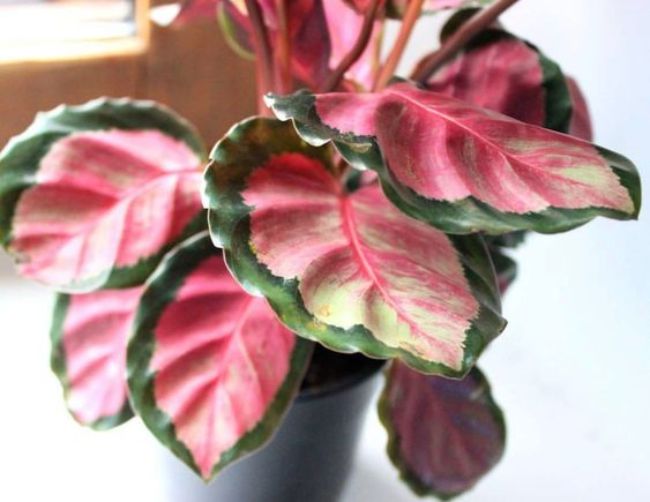
High Humidity
The growing secret everyone knows about Calatheas is that they like high humidity. Calatheas are great houseplants as far as temperatures and the need for moderate indirect light goes; but, if you don’t live in a tropical zone, humidity is where the trouble starts.
Low humidity can cause browned leaf edges and a frayed look. A good watering regimen helps the plant cope, but Calathea roseopicta tolerates no less than 40% humidity and prefers well over 60%.
You can raise humidity a few points by using pebble-filled water trays and grouping plants together … or use a room humidifier for an industrial solution. You can also read this article for other suggestions for raising humidity for your houseplants.
Calathea Roseopicta Temperature Requirements
Calathea roseopicta does well in comfortable indoor temperatures. They like the cooler side of the range, from 64ºF (18ºC) to 75ºF (24°C).
As long as they are well hydrated, the Roseopicta adapts better to warmer conditions than to cold. Avoid temperatures below 60ºF (15ºC).
Be mindful of sudden temperature changes and drafts. Becoming crispy-fried in the path of a heater is one of the most common causes of Calathea demise.
I’ve found that central heating in winter is a major challenge with Calathea roseopicta care. You need to be extra attentive to make sure humidity doesn’t fall too dramatically, causing brown leaf edges.
Fertilizing Calathea Roseopicta
For all that goes into producing its gorgeous leaves, the Roseopicta is actually a light feeder. Plants in a soilless mix will need feeding to bolster fertility, but those grown in nutrient-rich soil may not need to be fertilized at all.
There are two categories of fertilizer:
- Synthetic fertilizers can be effective and cost-effective, but you should dilute them to 1/4 to 1/2 of the recommended dosage. Roseopicta’s roots are delicate and burn easily from residue fertilizer.
- Organic fertilizers increase fertility naturally using natural products like worm castings, blood meal, or fish emulsion. These are safe for the plant and encourage healthy soil.
Only fertilize in the growing season when the plant can absorb it. Fertilizing in the fall or winter can create a toxic buildup of unused formula in the soil.
Personally, I use a balanced, water-soluble, synthetic fertilizer, made up to 1/4 to 1/2 of the recommended strength, and applied monthly in spring and summer. Here is a link to the exact fertilizer I use for all my Calatheas.
Flowering
The Roseopicta’s main attraction is picturesque tropical foliage, but they do produce a sprinkling of small white and purple flowers in the summer.
Some growers snip the blossoms to conserve the plant’s energy for growth – flowering consumes a lot of resources. Trimming buds or blooms won’t harm the plant.
Basic Pruning
It’s important to regularly trim away dead leaves and spent blooms. This eliminates a harbor for pathogens or pests … and gives you an opportunity to check the plant for pests or other problems.
Key tips:
- Make the cuts with sharp scissors or shears.
- Sterilize your cutting tools before and after each use. One easy method is to wipe the blades in isopropyl (rubbing) alcohol.
- Trim the stalks at soil level
- Cut away dead or dying material, but don’t be in a hurry to cut off a leaf that still has some green.
- Old outer leaves are shed naturally by the plant, but pay attention to multiple yellow leaves, especially if they are close to the plant’s interior.
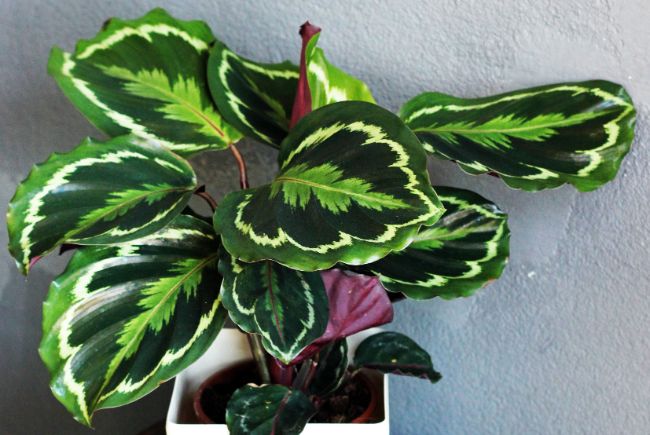
How To Repot Calathea Roseopicta
Repotting too frequently can make providing good Calathea roseopicta care more difficult. They don’t like having their roots disturbed and seem to like being slightly rootbound.
The general recommendation is to repot no more frequently than every second year. Repotting in spring will ensure your plant is growing strongly and can weather the stress of the repotting process more easily.
Only repot up one size: one or two inches wider in diameter. It’s important to avoid repotting into a container too large for the root system. The excess soil makes it more difficult to water correctly; it takes longer to dry out, which encourages rot pathogens.
Replenish the soil using the same composition as the old mix, if possible. You can upgrade the soil for the health of the plant, but it will need time to recuperate.
Remember that repotting is actually a drastic operation from the plant’s point of view. They need time to recover.
How To Propagate Calathea Roseopicta
A healthy Calathea roseopicta isn’t hard to propagate, but there’s basically only one practical way to do it: division. Calatheas don’t propagate through cuttings, and growing from seed is slow and time-intensive.
It’s best to divide a plant when it has many young plantlets.
Here are the steps:
- Gently unpot the plant.
- Carefully separate the Roseopicta clumps. Include roots and at least one leaf with each new plant.
- Plant in a small, snug pot. Use the same soil composition as the parent’s mix.
- Keep the soil moist and give the new plant moderate indirect light. If humidity is low, create an enclosure with clear plastic around the plant to raise it.
- Once you see new growth, gradually remove any tenting and begin normal care.
Calathea Roseopicta Care Tips
- Remember that your Calathea roseopicta’s precious leaves dry up immediately if placed too close to a heat source or if they are exposed to a heated draft.
- Check your plant every few days to see if it needs to be watered. Don’t try to enforce a weekly watering regime, as it is likely to end in disaster. Always check soil before watering.
- Periodically clean the leaves by washing or dusting them. This is a great opportunity to inspect the plant’s health and look for pests.
- Even if humidity is acceptable, grouping tropical plants can beneficially increase levels.
- If you see leaf spots or burned tips, consider your water source. Calathea roseopicta care can be impacted by water that is highly mineralized, or contains other chemicals, and may do better with purified water.
Non-Toxic
The Roseopicta is non-toxic and won’t harm your dogs, cats, or other animals – it’s safe for children, too.
Calathea Roseopicta Varieties
The Roseopicta has been bred into a variety of subspecies with different colors and/or leaf patterns.
Some of the most popular include:
‘Corona’ – This variegated beauty has creamy white leaves with wide, dark-green bands along their edge. Its stems are burgundy hued.
‘Cynthia’ – A busy variety that features dark green leaves with a thick band of silvery variegation along the edges and center line. Random pink-to-red hues wash over the whole leaf.
‘Dottie’ – The most common subspecies and widely available. The Dottie has a bright pink, oval leaf pattern with a wide midrib.
‘Eclipse’ – This variety’s large, dark green leaves have a broad band of silver-white variegation along their edges. A reddish hue shows randomly across the variegated surface.
‘Illustrus’ – This cultivar’s bright green leaves provide a cheerful backdrop to its feathered pink markings. The center is colored with rosy shades of mauve.
‘Little Princess’ – A compact variety with highly oversized, rounded leaves and brilliant pink markings.
‘Medallion’ – An exotic, complex variety. The large leaves are banded with three concentric rings: an inner lime-green leaf, a middle swath of dark green, and a wide outer grey-white leaf shape with a thin dark green edge. The undersides of the leaves are a dark red to purple colorCa.
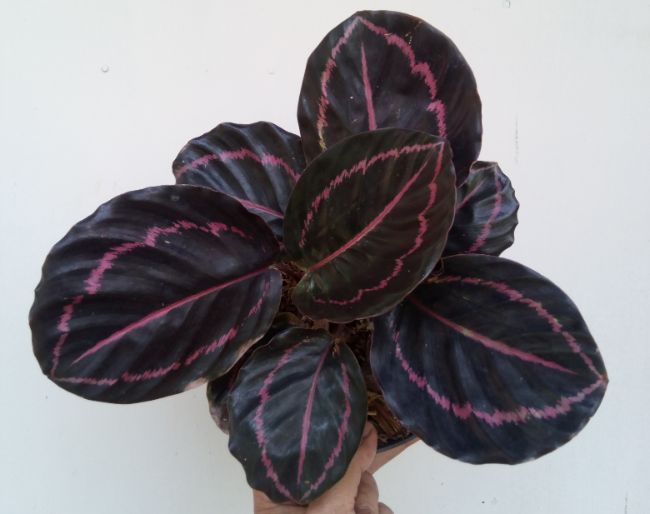
Pests
A Roseopicta can fall prey to most houseplant pests.
It’s much better to catch an infestation before it really takes hold – the fight is generally a battle of attrition with repeated treatments. Inspect your plants regularly, looking closely at stem joints and underneath the leaves.
The common pests your Calathea roseopicta can host are mealybugs, scale, aphids, and diabolical spider mites. If you don’t have a lot of humidity in your plant’s environment, mites can be persistent.
If you find pests on your Calathea roseopicta, the first, and most important thing you must do, is isolate the affected plant from any others. Pests can spread rapidly, making it much more difficult to control an infestation.
Horticultural oils and insecticidal soap treatments are effective and safe for you and the plant, and also your surroundings. It’s a good idea to give the plant a shower with enough water pressure to knock off as many of the pests as possible before applying the treatment (cover the soil to avoid unwanted soaking).
Cover the plant completely with the oil or soapy solution: the treatment is only effective if it touches the pest before drying. Repeat every four to six days until the infestation has been eliminated.
Some growers have success using Diatomaceous Earth (DE) for spider mites. The powder must be dry to be effective; to apply, the plant can be coated when dry and washed off at watering time.
Disease
Bacterial and fungal infections are the most common diseases to affect Calathea roseopicta. These are often the result of too much moisture: Overwatering and chronically wet leaves are open doors to disease.
Trouble usually shows up as spotting in the leaves. Small lesions can often be handled by keeping water off the leaves and reducing moisture levels.
Leaves with large lesions should be safely trimmed and discarded. Dark green or black lesions can signal infection by <em>pseudomonas</em>; you can attempt treatment with copper bactericides or other proposed remedy, but it’s usually safest to destroy the victim plants.
Calatheas can also contract the Cucumber mosaic virus (CMV), which causes yellow jagged streaks on leaves. Roseopictas don’t suffer greatly from this infection, but they can transmit it to more susceptible plants.
Common Calathea Roseopicta Care Questions
Why Are My Calathea Roseopicta’s Leaves Turning Brown And Crispy On The Edges?
This is a common complaint from conscientious growers who strive to provide the right conditions but have less-than-ideal humidity. If your Calathea roseopicta struggles with humidity, its foliage will turn brown on the edges; random dry, brown spots can also appear on the leaves.
Other causes for browning leaves include direct sunlight and receiving too much heat.
A humidifier is the surest solution. Grouping your plants and using water trays can be useful if you only need to raise humidity a few points.
Cutting back the brown leaves to make way for fresh green ones is typically the best solution. This type of leaf damage won’t repair itself, unfortunately. New growth will have to replace it.
Why Are My Calathea Roseopicta’s Leaves Turning Yellow?
The classic cause for yellow leaves is overwatering. If you see a yellow leaf and the soil is damp, let the top half-inch dry completely before rewatering. Overwatering is a really common issue with Calathea roseopicta care.
A less common cause of yellow leaves is toxicity in the soil from leftover fertilizer. If this is an issue, reduce feeding and keep the mix well flushed. Wait until it’s time to water and run an excess freely through the soil; repeat after draining. Flush either periodically or with every watering.
Can I Cut Brown Areas Off My Calathea Roseopicta’s Leaves?
Many growers like to leave partially healthy leaves on their Calathea roseopicta until they die naturally, but you don’t have to let husks and brown spots spoil the picture.
A leaf’s brown spots are dead. They aren’t coming back. You can cut them away without further damaging the plant. The only rule is to avoid cutting into living leaf tissue (or it will turn brown, too). Cut within the dead area and leave an eighth-inch margin to keep the brown zone from spreading.
Related Articles
- 12 Stunning Calathea Varieties You Will Love
- How To Care For Calathea Ornata
- How To Propagate Calatheas
- A Guide To Growing Calathea Crocata
- Why Are My Calathea’s Leaves Curling?
- How To Care For Calathea Makoyana
- How To Care For Calathea Orbifolia
- How To Grow A Zebra Plant (Calathea Zebrina)
- Calathea Leaves Turning Yellow – Causes And Solutions
- How To Care For Calathea Warscewiczii (Calathea Jungle Velvet)
- How To Grow Calathea Lancifolia
- Calathea Musaica Care Guide

